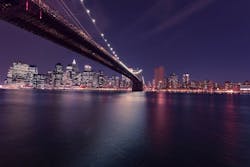New York Considering $119 Billion Sea Wall for Storm Protection
A six-mile-long barrier is the largest of five options the Army Corps of Engineers is studying to protect the New York area as storms become more frequent, reported the New York Times.
Those in support of the barrier miles from Manhattan’s coast say it would be the best solution for protecting the most people, properties and landmarks, including the Statue of Liberty, from a storm surge, reported the New York Times.
The Corps’s barrier designs aim to address only storm surges, according to the New York Times. This barrier would thus be unable to tackle flooding from high tides and storm runoff. There is also the potential the barrier could trap sewage and toxins, which would threaten New York’s waterways.
NYC Sea Wall Would Take 25 Years to Build
It is estimated that the sea wall will cost $119 billion, and it is unclear if the city, New York State, New Jersey and Congress will agree to jointly fund the project. The barrier would also take 25 years to build, according to the New York Times. There is also the likely chance the sea wall could be obsolete within decades because the Corps’ estimates of future sea levels are too low.
“These sea gates will not be able to protect communities from flooding caused by rising tides and rising sea levels, and once they’re built, that’s it,” said Scott M. Stringer, the New York City comptroller in a recent letter to the Corps.
The Corps says that its designs can be modified for higher seas, however. Three of the other proposals involve different combinations of smaller sea walls at the mouths of various New York City waterways, and the final option includes shore-based measures only, according to the New York Times.
“If there’s an economically viable and ecologically sound solution that can reduce risks to New York and New Jersey, we should put that forward,” said Clifford S. Jones III, planning chief for the Corps’s New York district.
Many resilience planning and environmental experts allege it could make matters worse, however. Environmental advocates believe any barriers, even when open on days without major storms, would change the natural flow of sediment and salt in the Hudson River estuary, ultimately affecting migration and feeding of marine life.
New York City, New York State and New Jersey would all have to approve any barrier and foot 35% of the bill, reported the New York Times.
The agency has received several thousand comments objecting to aspects of the proposals and has promised to hold more public hearings.
“Barriers are a shiny object, a silver-bullet fix luring us away from where we need to go. The danger of one big wall is that if it fails, we’re all in danger. We need layered solutions,” said Paul Gallay, head of Riverkeeper, an advocacy group for the Hudson.


